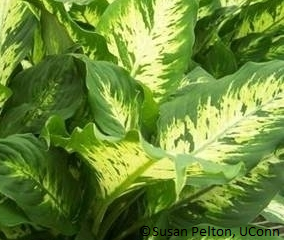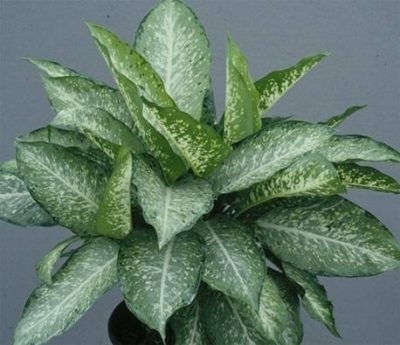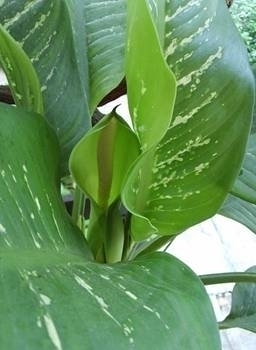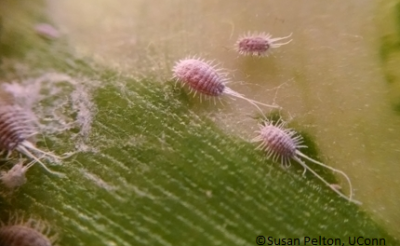Native to Central and South America and a relative of our skunk cabbage, Symplocarpus foetidus, Dieffenbachia is a broad-leaved foliage plant with thick succulent stems. A popular house plant because of its ease of culture, it is available in a variety of leaf patterns.

Dieffenbachia’s common name, Dumbcane, comes from the fact that all plant parts contain raphides; crystalline, needle-like structures which are ejected when cell walls are damaged. Raphides are believed to be a defense mechanism against browsing by animals, since ingestion of the plant will cause stinging and burning to the mouth and throat with symptoms persisting for up to two weeks. This reaction can disable speech, hence its common name. Exposure to the eyes is particularly painful. Handle the plant with care when trimming or making cuttings for propagation. Small children and pets should be kept away from dieffenbachia plants.
Care
Soil
Use a loose, fertile, high organic medium. Many different mixes can be used. Plants can be grown in pure peat; peat and perlite (1:1), soil and peat (1:1); or soil, peat and perlite/vermiculite (1:1:1). The growing medium should have good water-holding capacity and be well drained.
Fertilizer Needs
It is difficult to give specific fertilizer recommendations for foliage plants. Plants given a minimal amount of nutrients will grow slowly and retain a desired shape. If the plants are growing in limited light, they require less frequent fertilization. Dieffenbachias are considered heavy feeders. As a general guide, use a complete fertilizer such as 20-20-20 and feed every 4-6 weeks only during the active growing season.
Water
Maintain moderately moist soil. Watering is an important part of growing dieffenbachia. Water thoroughly and then not again until the surface of the potting medium is dry to the touch. Plants can be rooted and grown in water. Plants grown in soil should not be water logged; Dieffenbachia will not tolerate constant overwatering.
A relatively moist atmosphere results in vigorous growth, because its large leaves may dry up in a hot room. Maintain humidity by grouping plants or with a pebble tray.
Light and Temperature
Dieffenbachia tolerates a wide range of light conditions. They will grow in heavy shade and can be used in dark areas of the home, but growth will be slowed. Best growth is achieved in bright indirect light.
Best growth occurs between 65º and 75ºF. The temperature should not drop below 50ºF.

Propagation
New plants can be made from stem cuttings. Use tip cuttings from the terminal portion of the plant or from small shoots that develop from lateral buds. Be sure to avoid contact of the plant juice with skin.
Stems that have become bare from dropped leaves can be cut into 2” pieces (with at least one lateral bud). Dry the cuttings for a day, then stick them in a rooting medium such as peat, sand, perlite or vermiculite. Stem cuttings establish roots faster in sphagnum moss than in sand, and cuttings from the top of the plant root faster than sections taken from the base of the stem.
Larger stems initiate roots faster than smaller stems, apparently because the larger stems contain more stored food. Air layering can be used when the plant becomes top-heavy or lanky with naked stems.
Flower
Dieffenbachia has a unique type of flower; a spathe and spadix make up the inflorescence (imperfect bloom). The spathe is green and often resembles an unfolding leaf. It persists for a long period of time. The spadix is erect, off-white in color, and is often hidden. The male flowers are near the tip of the spadix and the female flowers occur at the base. The flowers are insect pollinated. If fruit develops, it is berry-like in appearance. Dieffenbachia seldom flower indoors, and the blooms are not showy.

Dieffenbachia troubles
- Yellowing and dropping off of lower leaves ---- overwatering
- Plant rots off at the base ---- overwatering.
- Bacterial Rot/ Blight (Dickeya dieffenbachiae) ---- a bacterial pathogen that causes soft rot
- Leaves dry up ---- low humidity in the room. Position away from radiators, group plants, use pebble trays.
- Lower leaves fall off and plant becomes leggy ---- insufficient light
- Ants can cause considerable damage because they carry certain aphids, which in turn secrete a honeydew. The ants gather and feed on this honeydew. Fungus may develop.
- Mealybugs: The nymphs of this pest feed on the sap of the plant by piercing the outer layer of plant tissue and secrete the honeydew that is attractive to ants (see above). Mealybugs can be controlled by wiping the area with a cotton ball dipped in rubbing alcohol.
- Tip burn: droplets of water may develop during the early morning hours on the tips of leaves. This is called “guttation.” If there are excessive fertilizer salts in the soil, these salts will be in solution in this water droplet. When the droplets evaporate, the salts remain on the tip of the leaf and cause tip burn.
- Brown leaf edges and/or leaf tips ---- too much fertilizer; too dry for short periods
- Lower leaf drop ---- sudden changes in temperature, or plant is in a drafty location
- Leaf yellowing or discoloration ---- caused by plant being in full sunlight

Despite good cultural practices, pests and diseases at times may appear. Chemical control should be used only after all other methods have failed.
For pesticide information please call UConn Home and Garden Education Center weekdays, in Connecticut call toll free 877-486-6271. Out of state call 860-486-6271.
Cultivars and species
Dieffenbachia amoena – One of the most commonly grown. Rapid grower. Leaves are often 18” long, dark green with narrow, white slanting stripes on either side of midrib. Well suited as a specimen plant, it is frequently kept in a smaller pot in order to control the height. More tolerant of cool temperatures than other Dumbcanes. A cultivar of this species is ‘Tropic Snow,’ which has smaller leaves (12”) and more variegation. Makes an excellent house plant.
D. X bausei – Has light, almost yellow-green leaves flecked with yellow and white spots. Mature leaves are 9-11” long and 3-5” wide.
D. ‘Exotica’ (Arvida) One of the showier dieffenbachias. Predominant leaf color is ivory, with many small green splashes. Leaf margins have a narrow green band, with a creamy-white midrib.
D. maculata – This is the correct scientific name for Dieffenbachia picta, commonly sold as Spotted Dumbcane. This plant has ivory-white marbling and blotching on grass-green leaves 10-14” long and 6-8” wide.
Cultivars of D. maculata include ‘Perfection’ with leaves 8” long and 4” wide. Lower, smaller leaves are solid green and mature leaves are intensely variegated. The leaf margins remain green. This plant suckers freely and forms a multi-stem plant. It is a slow-growing plant which can be used as a specimen or paired with a taller-growing variety. ‘Rudolph Roehrs’ is one of the most important Dieffenbachias. Its leaves are entirely yellow with ivory-white blotches. The midrib and leaf edges are dark green. Because of the large amount of white variegation, leaf burn can occur if the plant is exposed to strong sunlight. This plant has a tendency to revert to the parent plant’s characteristics. When this happens, the leaves may appear deformed or buckled because of the more vigorous growth of the parent type. ‘Superba’ has thicker leaves and is more durable than the species, with dense sprinkling of white variegation.
Toxicity
The following is for information only and not for use in the treatment or management of an actual poison exposure. If you have an exposure, you should call your local emergency number (such as 911) or the CT Poison Control Center at 1-800-222-1222 immediately.
Poisonous Ingredient
- Oxalic acid
- Asparagine, a protein found in this plant
Symptoms
- Burning in mouth or throat
- Damage to cornea of the eye
- Diarrhea
- Eye pain
- Hoarse voice
- Nausea or vomiting
- Swelling in mouth or tongue
Home Care
Wipe out the mouth with a cold, wet cloth. Give milk to drink. Call poison control for further guidance.
Before Calling Emergency Determine the following information:
- The patient's age, weight, and condition
- The parts of the plant that were eaten
- The time swallowed
- The amount swallowed
Poison Control
The National Poison Control Center (800) 222-1222 can be called from anywhere in the United States. This national hotline number will let you talk to experts in poisoning. They will give you further instructions.Take the plant with you to the hospital, if possible
This is a free and confidential service. All local poison control centers in the United States use this national number. You should call if you have any questions about poisoning or poison prevention. It does NOT need to be an emergency. You can call for any reason, 24 hours a day, 7 days a week.
For pesticide information or other questions please call toll free: 877-486-6271.
Revised by UConn Home and Garden Education Center 2016.